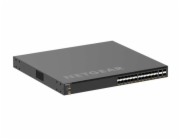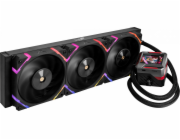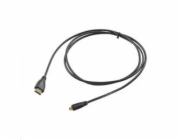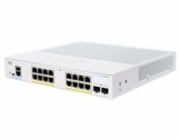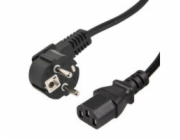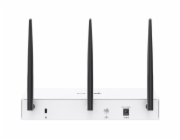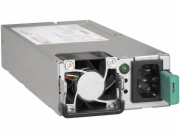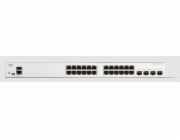KATEGORIE
Kategorie: Síťové prvky aktivní
227062 Kč
cena s DPH
Netgear 48PT M4350-36X4V MANAGED SWITCH
1867 Kč
cena s DPH
Na popisu produktu pracujeme a doplníme jej v nejbližší možné době. Produkt je možné zakoupit.
347 Kč
cena s DPH
Charge & Sync MFI opletený kabel
S tímto kabelem snadno nabijete či zazálohujete veškerá svá z...
195 Kč
cena s DPH
AKY AK-HD-15R Akyga HDMI / micro HDMI cable AK-HD-15R ver. 1.4 1.5m
11068 Kč
cena s DPH
Cisco switch CBS350-16FP-2G-EU - REFRESH
CISCO REFRESH jsou repasované produkty, které společnost CISCO dodává s certifikací kvality, zárukou a servisní podporou odpovídající ekvivalentnímu novému produktu
Řízené switche řady Cisco Business 350 jsou spolehlivými stavebními prvky pro sítě malých firem. Díky intuitivnímu ovládacímu panelu, pokročilým funkcím a všudypřítomnému zabezpečení urychlují spravované switche řady Cisco Business 350 vaši digitální transformaci.
Záruka platná do End of Support 31. 10. 2029.
Oznámení End of Life pro CISCO CBS350
Stránky produktu: CBS350-16FP-2G-EU
Quick start guide: Quick start guide
Switching capacity and forwarding rate (All switches are wire speed and nonblocking) Capacity in Millions of Packets per Second (mpps) (64-byte packets) 26,78
Switching Capacity in Gigabits per Second (Gbps) 36
Layer 2 switching Spanning Tree Protocol (STP) Standard 802.1d Spanning Tree support
Fast convergence using 802.1w (Rapid Spanning Tree [RSTP]), enabled by default
Multiple Spanning Tree instances using 802.1s (MSTP); 8 instances are supported
Per-VLAN Spanning Tree Plus (PVST+) and Rapid PVST+ (RPVST+); 126 instances are supported
Port grouping/link aggregation Support for IEEE 802.3ad Link Aggregation Control Protocol (LACP)
Up to 8 groups
Up to 8 ports per group with 16 candidate ports for each (dynamic) 802.3ad link aggregation
VLAN Support for up to 4,094 VLANs simultaneously
Port-based and 802.1Q tag-based VLANs; MAC-based VLAN; protocol-based VLAN; IP subnet-based VLAN
Management VLAN
Private VLAN with promiscuous, isolated, and community port
Private VLAN Edge (PVE), also known as protected ports, with multiple uplinks
Guest VLAN, unauthenticated VLAN
Dynamic VLAN assignment via RADIUS server along with 802.1x client authentication
CPE VLAN
Voice VLAN Voice traffic is automatically assigned to a voice-specific VLAN and treated with appropriate levels of QoS. Voice Services Discovery Protocol (VSDP) delivers network wide zero-touch deployment of voice endpoints and call control devices
Multicast TV VLAN Multicast TV VLAN allows the single multicast VLAN to be shared in the network while subscribers remain in separate VLANs. This feature is also known as Multicast VLAN Registration (MVR)
VLAN Translation Support for VLAN One-to-One Mapping. In VLAN One-to-One Mapping, on an edge interface customer VLANs (C-VLANs) are mapped to service provider VLANs (S-VLANs) and the original C-VLAN tags are replaced by the specified S-VLAN
Q-in-Q VLANs transparently cross a service provider network while isolating traffic among customers
Selective Q-in-Q Selective Q-in-Q is an enhancement to the basic Q-in-Q feature and provides, per edge interface, multiple mappings of different C-VLANs to separate S-VLANs
Selective Q-in-Q also allows configuring of Ethertype (Tag Protocol Identifier [TPID]) of the S-VLAN tag
Layer 2 protocol tunneling over Q-in-Q is also supported
Generic VLAN Registration Protocol (GVRP)/Generic Attribute Registration Protocol (GARP) Generic VLAN Registration Protocol (GVRP) and Generic Attribute Registration Protocol (GARP) enable automatic propagation and configuration of VLANs in a bridged domain
Unidirectional Link Detection (UDLD) UDLD monitors physical connection to detect unidirectional links caused by incorrect wiring or cable/port faults to prevent forwarding loops and black holing of traffic in switched networks
Dynamic Host Configuration Protocol (DHCP) Relay at Layer 2 Relay of DHCP traffic to DHCP server in different VLAN; works with DHCP Option 82
Internet Group Management Protocol (IGMP) versions 1, 2, and 3 snooping IGMP limits bandwidth-intensive multicast traffic to only the requesters; supports 2K multicast groups (source-specific multicasting is also supported)
IGMP Querier IGMP querier is used to support a Layer 2 multicast domain of snooping switches in the absence of a multicast router
IGMP proxy The IGMP proxy provides a mechanism for multicast forwarding based on IGMP membership information without the need for more complicated multicast routing protocols.
Head-of-Line (HOL) blocking HOL blocking prevention
Loopback Detection Loopback detection provides protection against loops by transmitting loop protocol packets out of ports on which loop protection has been enabled. It operates independently of STP
Layer 3 IPv4 routing Wirespeed routing of IPv4 packets
Up to 990 static routes and up to 128 IP interfaces
IPv6 routing Wirespeed routing of IPv6 packets
Layer 3 Interface Configuration of Layer 3 interface on physical port, Link Aggregation (LAG), VLAN interface, or loopback interface
Classless Interdomain Routing (CIDR) Support for classless interdomain routing
RIP v2 Support for Routing Information Protocol version 2 for dynamic routing
Policy-Based Routing (PBR) Flexible routing control to direct packets to different next hop based on IPv4 or IPv6 Access Control List (ACL)
DHCP Server Switch functions as an IPv4 DHCP server serving IP addresses for multiple DHCP pools/scopes
Support for DHCP options
DHCP relay at Layer 3 Relay of DHCP traffic across IP domains
User Datagram Protocol (UDP) relay Relay of broadcast information across Layer 3 domains for application discovery or relaying of Bootstrap Protocol (BOOTP)/DHCP packets
Security ecure Shell (SSH) Protocol SSH is a secure replacement for Telnet traffic. Secure Copy Protocol (SCP) also uses SSH. SSH v1 and v2 are supported
Secure Sockets Layer (SSL) SSL support: Encrypts all HTTPS traffic, allowing highly secure access to the browser-based management GUI in the switch
IEEE 802.1X (Authenticator role) 802.1X: Remote Authentication Dial-In User Service (RADIUS) authentication and accounting, MD5 hash; guest VLAN; unauthenticated VLAN, single/multiple host mode and single/multiple sessions
Supports time-based 802.1X; dynamic VLAN assignment; MAC authentication
IEEE 802.1X supplicant A switch can be configured to act as a supplicant to another switch. This enables extended secure access in areas outside the wiring closet (such as conference rooms)
Web-based authentication Web-based authentication provides network admission control through web browser to any host devices and operating systems
STP Bridge Protocol Data Unit (BPDU) Guard A security mechanism to protect the network from invalid configurations. A port enabled for BPDU Guard is shut down if a BPDU message is received on that port. This avoids accidental topology loops
STP Root Guard This prevents edge devices not in the network administrator’s control from becoming Spanning Tree Protocol root nodes
STP loopback guard Provides additional protection against Layer 2 forwarding loops (STP loops)
DHCP snooping Filters out DHCP messages with unregistered IP addresses and/or from unexpected or untrusted interfaces. This prevents rogue devices from behaving as DHCP Servers.
IP Source Guard (IPSG) When IP Source Guard is enabled at a port, the switch filters out IP packets received from the port if the source IP addresses of the packets have not been statically configured or dynamically learned from DHCP snooping. This prevents IP address spoofing.
Dynamic ARP Inspection (DAI) The switch discards ARP packets from a port if there are no static or dynamic IP/MAC bindings or if there is a discrepancy between the source or destination addresses in the ARP packet. This prevents man-in-the-middle attacks.
IP/MAC/Port Binding (IPMB) The preceding features (DHCP Snooping, IP Source Guard, and Dynamic ARP Inspection) work together to prevent DOS attacks in the network, thereby increasing network availability
Secure Core Technology (SCT) Makes sure that the switch will
45483 Kč
cena s DPH
Řada přepínačů Aruba CX 6200 je ideální pro pobočky a pro malé a střední podniky. Snadno použitel...
127 Kč
cena s DPH
Vhodný k adaptérům: 77011192, 77011193, 77011272, 77011284, 77011295, B0A001-00390000, B0A001-003...
2080 Kč
cena s DPH
Vodové chlazení Azza Blizzard SP 240 (LCAZ-240R-GRB SP)
4662 Kč
cena s DPH
Směrovače Festa VPN nabízejí obchodní funkce s uživatelsky přívětivou jednoduchostí. Naše bezplatná centralizovaná správa založená na cloudu, která je dostupná prostřednictvím aplikace Festa nebo web
3907 Kč
cena s DPH
Features Full HD resolution for live streaming and recordings Easy door opening via Tellur app (when connected to electromagnetic locks) POE (Power Over Ethernet) cables compatibility Integrated PIR motion sensor Night vision function Water and dust resistant (IP54 rating) Technical data Sensor type: 1/2.9 CMOS Sensor resolution: 2 Megapixels Lens: F:2.0 f:3.2mm View angle: 140° PIR motion sensor: Yes, up to 8 meters Image resolution: FullHD 1080P 1920*1080 Video compression: H.264 Bit rate: 32Kbps~2Mbps Frame rate: 30 fps Image flip: Horizontal by App Memory slot: MicroSD card class 10 min (up to 256GB), not included Door unlock support: Yes Cloud storage support: Yes Siri Shortcuts: Yes Google Home: Yes Amazon Alexa: Yes Night vision: Yes, up to 10 meters Audio communication: Two-way audio Network connectivity: 2.4G WiFi 802.11 b/g/n or Wired network Waterproof: IP54 Working condition temperature: −20°C to 50°C Working condition humidity: 10 ~ 95RH Power supply: DC 12~36V / AC 8~24V / 12~15V / 48V POE Wireless chime compatibility: Yes, indoor chime included Dimensions: 145 x 95 x 38mm Weight: 350g Color: Grey Package includes: 1 x Video DoorBell WiFi 1 x Mounting bracket 1 x DC 12V power adapter 1 x DC connection cable 1 meter 1 x Door unlock wiring cable 1 x POE injector 1 x Indoor chime 1 x Master card Yellow ""Add"" unlock card 1 x Master card Red ""Delete"" unlock card 5 x Blue user unlock card 1 x Screws kit 1 x Screw driver
20751 Kč
cena s DPH
Netgear M6100 1000W Redundantní PSU, LAN adaptér
16286 Kč
cena s DPH
Cisco Catalyst switch C1200-24P-4X
Řada Cisco Catalyst 1200 je další generací cenově dostupných chytrých přepínačů, které kombinují vysoký výkon a spolehlivost s kompletní sadou funkcí, které potřebujete pro malé a středně velké podnikové sítě. Přepínače fungují na přizpůsobeném softwaru operačního systému Linux a poskytují flexibilní možnosti správy, komplexní možnosti zabezpečení a funkce statického směrování na 3. vrstvě, které daleko přesahují možnosti neřízeného nebo levného přepínače a to za nižší cenu než u plně spravovaných přepínačů. Když potřebujete spolehlivé řešení pro sdílení online zdrojů a připojení počítačů, telefonů a bezdrátových přístupových bodů, chytré přepínače Catalyst řady 1200 poskytují ideální řešení za dostupnou cenu.
Stránky produktu: C1200-24P-4X
Performance Switching capacity and forwarding rate (All switches are wire-speed and nonblocking)
Capacity in millions of packets per second (mpps) (64-byte packets) 95,23
Switching capacity in gigabits per second (Gbps) 128
Layer 2 switching Spanning Tree Protocol (STP) Standard 802.1d spanning tree support
Fast convergence using 802.1w (Rapid Spanning Tree Protocol [RSTP]), enabled by default
Multiple spanning tree instances using 802.1s (MSTP); 8 instances are supported
Per-VLAN Spanning Tree Plus (PVST+); 126 instances are supported
Rapid PVST+ (RPVST+); 126 instances are supported
Port grouping/link aggregation Support for IEEE 802.3ad Link Aggregation Control Protocol (LACP)
Up to 4 groups
Up to 8 ports per group with 16 candidate ports for each (dynamic) 802.3ad Link Aggregation Group (LAG)
VLAN Support for up to 255 active VLANs simultaneously
Port-based and 802.1Q tag-based VLANs
Management VLAN
Guest VLAN
Auto Surveillance VLAN (ASV)
Voice VLAN Voice traffic is automatically assigned to a voice-specific VLAN and treated with appropriate levels of QoS. Voice Services Discovery Protocol (VSDP) delivers networkwide zero-touch deployment of voice endpoints and call control devices
Generic VLAN Registration Protocol (GVRP) and Generic Attribute Registration Protocol (GARP) Enable automatically propagation and configuration of VLANs in a bridged domain
Internet Group Management Protocol (IGMP) versions 1, 2, and 3 snooping Limits bandwidth-intensive multicast traffic to only the requesters; supports 255 multicast groups (source-specific multicasting is also supported)
IGMP querier Used to support a Layer 2 multicast domain of snooping switches in the absence of a multicast router
Head-of-Line (HOL) blocking HOL blocking prevention
Loopback detection Provides protection against loops by transmitting loop protocol packets out of ports on which loop protection has been enabled. It operates independently of STP
Layer 3 routing IPv4 routing Wire-speed routing of IPv4 packets
Up to 32 static routes and up to 16 IP interfaces
IPv6 routing Wire-speed routing of IPv6 packets
Layer 3 interface Configuration of Layer 3 interface on physical port, LAG, VLAN interface, or loopback interface
Classless Interdomain Routing (CIDR) Support for CIDR
Dynamic Host Configuration Protocol (DHCP) relay at Layer 3 Relay of DHCP traffic across IP domains
User Datagram Protocol (UDP) relay Relay of broadcast information across Layer 3 domains for application discovery or relaying of Bootstrap Protocol (BootP)/DHCP packets
Security Secure Sockets Layer (SSL) Encrypts all HTTPS traffic, allowing secure access to the browser-based management GUI in the switch
SSH Protocol SSH is a secure replacement for Telnet traffic. Secure Copy (SCP) also uses SSH. SSH v1 and v2 are supported.
IEEE 802.1X (authenticator role) RADIUS authentication, guest VLAN, single/multiple host mode, and single/multiple sessions
STP loopback guard Provides additional protection against Layer 2 forwarding loops (STP loops)
Secure Core Technology (SCT) Ensures that the switch will receive and process management and protocol traffic no matter how much traffic is received
Secure Sensitive Data (SSD) A mechanism to manage sensitive data (such as passwords, keys, and so on) securely on the switch, populating this data to other devices and a secure auto-configuration. Access to view the sensitive data as plain text or encrypted is provided according to the user-configured access level and the access method of the user
Trustworthy systems Trustworthy systems provide a highly secure foundation for Cisco products
Run-time defenses (Executable Space Protection [X-Space], Address Space Layout Randomization [ASLR], Built-In Object Size Checking [BOSC])
Port security Ability to lock source MAC addresses to ports and limit the number of learned MAC addresses
RADIUS Supports RADIUS authentication for management access. Switch functions as a client
Storm control Broadcast, multicast, and unknown unicast
DoS prevention DoS attack prevention
Multiple user privilege levels in CLI Level 1, 7, and 15 privilege levels
ACLs Support for up to 512 rules
Drop or rate limit based on source and destination MAC, VLAN ID, IPv4 or IPv6 address, IPv6 flow label, protocol, port, Differentiated Services Code Point (DSCP)/IP precedence, TCP/UDP source and destination ports, 802.1p priority, Ethernet type, Internet Control Message Protocol (ICMP) packets, IGMP packets, TCP flag; ACL can be applied on both ingress and egress sides
Time-based ACLs supported
Quality of service Priority levels 8 hardware queues
Scheduling Strict priority and Weighted Round-Robin (WRR) queue assignment based on DSCP and Class of Service (802.1p/CoS)
Class of service Port based, 802.1p VLAN priority based, IPv4/v6 IP precedence/Type of Service (ToS)/DSCP based, Differentiated Services (DiffServ), classification and re-marking ACLs, trusted QoS
Rate limiting Ingress policer, egress shaping and rate control per VLAN, per port, and flow based
Congestion avoidance A TCP congestion avoidance algorithm is required to reduce and prevent global TCP loss synchronization
Standards Standards IEEE 802.3 10BASE-T Ethernet, IEEE 802.3u 100BASE-TX Fast Ethernet, IEEE 802.3ab 1000BASE-T Gigabit Ethernet, IEEE 802.3ad Link Aggregation Control Protocol, IEEE 802.3z Gigabit Ethernet, IEEE 802.3x Flow Control, IEEE 802.3 ad LACP, IEEE 802.1D (STP), IEEE 802.1Q/p VLAN, IEEE 802.1w RSTP, IEEE 802.1s Multiple STP, IEEE 802.1X Port Access Authentication, IEEE 802.3af, IEEE 802.3at, RFC 768, RFC 783, RFC 791, RFC 792, RFC 793, RFC 813, RFC 879, RFC 896, RFC 826, RFC 854, RFC 855, RFC 856, RFC 858, RFC 894, RFC 919, RFC 920, RFC 922, RFC 950, RFC 951, RFC 1042, RFC 1071, RFC 1123, RFC 1141, RFC 1155, RFC 1157, RFC 1213, RFC 1215, RFC 1286, RFC 1350, RFC 1442, RFC 1451, RFC 1493, RFC 1533, RFC 1541, RFC 1542, RFC 1573, RFC 1624, RFC 1643, RFC 1700, RFC 1757, RFC 1867, RFC 1907, RFC 2011, RFC 2012, RFC 2013, RFC 2030, RFC 2131, RFC 2132, RFC 2233, RFC 2576, RFC 2616, RFC 2618, RFC 2665, RFC 2666, RFC 2674, RFC 2737, RFC 2819, RFC 2863, RFC 3164, RFC 3411, RFC 3412, RFC 3413, RFC 3414, RFC 3415, RFC 3416, RFC 4330
IPv6 IPv6 IPv6 host mode
IPv6 over Ethernet
Dual IPv6/IPv4 stack
IPv6 Neighbor Discovery (ND)
IPv6 stateless address auto-configuration
Path Maximum Transmission Unit (MTU) discovery
Duplicate Address Detection (DAD)
ICMP version 6
IPv6 over IPv4 network with Intrasite Automatic Tunnel Addressing Protocol (ISATAP) support
IPv6 QoS Prioritizes IPv6 packets in hardware
IPv6 ACL Drop or rate-limit IPv6 packets in hardware
Multicast Listener Discovery (MLD v1/2) snooping Delivers IPv6 multicast packets only to the required receivers
IPv6 applications Web/SSL, Telnet server/SSH, Ping, Traceroute, Simple Network Time Protocol (SNTP), Trivial File Transfer Protocol (
10008 Kč
cena s DPH
Aruba AP-635 (RW) Tri-radio 2x2:2 802.11ax Wi-Fi 6E Internal Antennas Campus AP RENEW R7J27A
Aruba 630 Series Campus Access Points
Fast, resilient, and secure Wi-Fi 6E connectivity
For enterprises who need more wireless capacity and wider channels, Aruba 630 Series Campus APs are designed to take advantage of the 6 GHz band via three dedicated radios. By using the 6 GHz band, capacity is more than doubled - so you can meet growing demand due to bandwidth-hungry video, increasing numbers of client and IoT devices and growth in cloud. Unique to Aruba, the Aruba 630 Series includes ultra tri-band filtering and dual 2.5 Gbps ethernet ports to eliminate coverage gaps, provide greater resiliency, and deliver fast, secure connectivity
Aruba 630 Series Campus Access Points
Key Features
Unlocks the 6 GHz band to more than double the available capacity.
Comprehensive tri-band coverage across 2.4 GHz, 5 GHz, and 6 GHz to deliver 3.9 Gbps maximum aggregate data rate.
Up to seven 160 MHz channels in 6 GHz support low-latency, bandwidth-hungry applications like high-definition video and augmented reality/virtual reality applications.
Unique ultra-triband filtering enables 5 GHz and 6 GHz to operate without restrictions or interference.
High availability with 2.5 Gbps dual ethernets port for hitless failover of ethernet and power.
Standard Features
More Capacity and Wider Channels
The Aruba 630 Series APs are designed to take advantage of the 6 GHz band, which translates into far greater speeds, wider channels for multi-gigabit traffic, and less interference. It delivers 3.9 Gbps maximum aggregate data rates Tri-radio, 2x2:2 MIMO in all three bands (3.9 Gbps aggregate peak).
Band
Channel Size
Maximum throughput
6GHz
160MHz
2.4Gbps
5GHz
80MHz
1.2Gbps
2.4GHz
20MHz
3.9 Gbps
Advantages of 6GHz
Wi-Fi 6E provides up to 1200 MHz in the 6 GHz band for higher throughput and improved application performance. With up to seven 160 MHz channels, Wi-Fi 6E can better support low-latency, bandwidth hungry applications like high-definition video and artificial reality/virtual reality applications. Only Wi-Fi 6E capable devices can use the 6 GHz band so there is no interference or slowdowns due to legacy devices.
Device class support
The Aruba 630 Series APs are part of the low power indoor (LPI) device class. This fixed indoor-only class uses lower power levels and does not require an Automated Frequency Coordination service (AFC) to manage incumbent outdoor services which is required for standard class APs.
Less Interference
Aruba 630 Series Access Points include Aruba s ultra tri-band filtering, which enables enterprises to take advantage of the high end of 5 GHz with the lower end of 6 GHz without experiencing interference. Since there is only 50 MHz between 5 GHz and the 6 GHz, without advanced filtering, enterprises would likely experience problems between the bands and would therefore be limited in the number of channels available. By applying advanced filtering capabilities, enterprises can take full use of available spectrum without
creating coverage gaps or islands.
Business Continuity
The Series 630 APs provide high availability with two HPE Smart Rate ethernet ports for hitless failover for both data and power. Configurable to 1 or 2.5 Gbps, these dual ports provide business continuity for mission critical applications
Global Readiness
While the need for more Wi-Fi capacity is recognized across the globe, countries are approaching 6 GHz differently. The Aruba 630 Series APs are set up to automatically update regulatory rules once 6E regulations have been approved and certified.
Extend the Benefits of Wi-Fi 6
The Aruba 630 Series APs are based on the 802.11ax standard, which means that all its efficiency and security enhancements are also available on the 6 GHz band. Features include Orthogonal frequency-division multiple access (OFDMA), bi-directional multi-user MIMO as well as other capabilities built into Aruba s Wi-Fi 6 access points.
Advantages of OFDMA
This capability allows Aruba s APs to handle multiple 802.11ax capable clients on each channel simultaneously, regardless of device or traffic type. Channel utilization is optimized by handling each transaction via smaller sub-carriers or resource units (RUs), which means that clients are sharing a channel and not competing for airtime and bandwidth.
Wi-Fi Optimization
Client optimization
Aruba s patented AI-powered ClientMatch technology eliminates sticky client issues by steering a client to the AP where it receives the best radio signal. Client Match steers traffic from the noisy 2.4 GHz band to the preferred 5 GHz or 6 GHz band depending on client capabilities. ClientMatch also dynamically steers traffic to load balance APs to improve the user experience.
Automated Wi-Fi radio frequency management
To optimize the user experience and provide greater stability, Aruba AirMatch allows organization to automate network optimization using machine learning. AirMatch provides dynamic bandwidth adjustments to support changing device density, enhanced roaming using an even distribution of Effective Isotropic Radiated Power (EIRP) to radios, and real-time channel assignments to mitigate co-channel interference.
Application Assurance
With Air Slice, organizations can provide application assurance to their users that goes beyond the traditional capabilities of airtime fairness. After the SLAs are configured, Air Slice monitors network usage, automatically allocates radio resources, and dynamically adjusts radio resources as new users connect and applications sessions begin or end.
Aruba Advanced Cellular Coexistence (ACC)
Unique to Aruba, Advanced Cellular Coexistence uses built-in filtering to automatically minimize the impact of interference from cellular networks, distributed antenna systems (DAS), and commercial small cell or femtocell equipment.
Intelligent Power Monitoring (IPM)
For better insights into energy consumption, Aruba APs continuously monitor and report hardware energy usage. Unlike other vendor s access points, Aruba APs can also be configured to enable or disable capabilities based on available PoE power - ideal when wired switches have exhausted their power budget. Enterprises can deploy Wi-Fi 6E APs and update switching and power at a later if needed based on their actual usage. D
APS as an IoT Platform
The Aruba 630 Series includes an integrated Bluetooth 5 and 802.15.4 radio for Zigbee support to simplify deploying and managing IoT-based location services, asset tracking services, security solutions and IoT sensors. There is also a USB-port extension to provide IoT connectivity to a wider range of devices. These IoT capabilities allows organizations to leverage the Aruba APs as an IoT platform, which eliminates the need for an overlay infrastructure and additional IT resources and can accelerate IoT initiatives.
In addition, Target Wake Time (TWT) establishes a schedule for when clients need to communicate with an AP. This helps improve client power savings and reduces airtime contention with other clients, which is ideal for IoT.
Aruba Secure Infrastructure
The Aruba 630 Series includes build-security capabilities such as:
WPA3 and Enhanced Open
Support for stronger encryption and authentication is provided via the latest version of WPA for enterpriseprotected networks. Enhanced Open offers seamless new protection for users connecting to open networks where each session is automatically...









